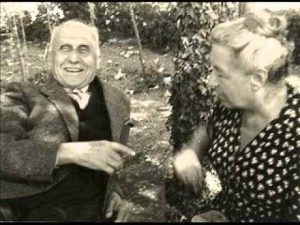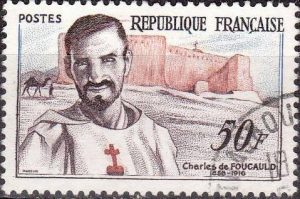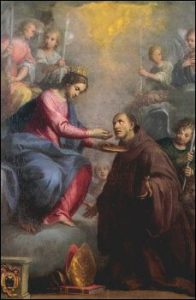 The Quattrocchis are the first married couple to be beatified together (in 2011). We have few married couples among the saints and blesseds in comparison to those in religious life and priesthood. It was Pope John Paul II who held up for us the Quattrocchis who lived an ordinary life in an extraordinary way.
The Quattrocchis are the first married couple to be beatified together (in 2011). We have few married couples among the saints and blesseds in comparison to those in religious life and priesthood. It was Pope John Paul II who held up for us the Quattrocchis who lived an ordinary life in an extraordinary way.
Luigi, a lawyer and civil servant, died in 1951 at the age of 71; Maria, who dedicated herself to her family and to several charitable and social Catholic movements, died in 1965 at the age of 81.
The cause for Beatification for Maria and Luigi Beltrame Quattrocchi was opened on 25 November 1994 and, on 21 October 2001, the Holy Father John Paul II raised the married couple to the honour of the altars. On 28 October 2001, the relics of Luigi and Maria were transferred to their crypt in the Shrine of Divino Amore (Divine Love) at Rome.
Homily of Pope Saint John Paul II for the first beatification of a married couple together: Luigi Beltrame Quattroccchi and Maria Corsini, (11/25):
“… they could accompany their children in vocational discernment, training them to appreciate everything “from the roof up”…”
1. “And when the Son of man comes, will he find faith on earth?” (Lk 18,8).
The question with which Jesus ends the parabable on the need “always to pray and not lose heart” frightens our soul. It is a question that is not immediately followed by an answer: indeed, it is intended as a challenge to each person, each ecclesial community, each human generation. Each one of us must give an answer. Christ wants to remind us that human life is directed to the final meeting with God; but in this perspective he asks himself whether, on his return, he will find souls ready, waiting for him, to enter the Father’s house with him. This is why he says to everyone “Watch, therefore, for you know neither the day nor the hour” (Mt 25,13).
Dear brothers and sisters! Dear famlies! Today we have gathered for the beatification of a married couple: Luigi and Maria Beltrame Quattrocchi. With this solemn ecclesial act, we intend to highlight an example of a positive reply to Christ’s question. The husband and wife lived in Rome in the first half of the 20th century, a century in which faith in Christ was harshly tried, and gave a positive reply. Even in those difficult years, the husband and wife, Luigi and Maria, kept the lamp of the faith burning – lumen Christi – and passed it on to their four children, three of whom are here today in this basilica. Dear friends, this is what your mother wrote about you: “We brought them up in the faith, so that they might know and love God” (L’Ordito e la trama, p. 9).
But your parents also handed on the burning lamp to their friends, acquaintances, colleagues…. And now, from heaven, they are giving it to the whole Church.
Together with the relatives and friends of the new Blesseds, I greet the religious authorities participating in this celebration, starting with Cardinal Camillo Ruini and the other Cardinals, Archbishops and Bishops present. I also greet the civil authorities, and, in a special way, the President of Italy and the Queen of Belgium.
2. There could be no happier nor more momentous an occasion than today to celebrate the 20th anniversary of the Apostolic Exhortation “Familiaris consortio”. This document, which even today remains a guiding light in the field, while highlighting the centrality of marriage and the mission of the family, particularly asks spouses to follow the path of holiness by virtue of the sacramental grace, which “is not exhausted in the actual celebration of the sacrament of marriage, but rather accompanies the married couple throughout their lives” (Familiaris consortio, n. 56). The beauty of this path shines out in the witness of the Blessed couple Luigi and Maria, an exemplary expression of the Italian people, who demonstrated the great importance of marriage and the family that it brings forth.
This couple lived married love and service to life in the light of the Gospel and with great human intensity. With full responsibility they assumed the task of collaborating with God in procreation, dedicating themselves generously to their children, to teach them, guide them and direct them to discovering his plan of love. From this fertile spiritual terrain sprang vocations to the priesthood and the consecrated life, which shows how, with their common roots in the spousal love of the Lord, marriage and virginity may be closely connected and reciprocally enlightening.
Drawing on the word of God and the witness of the saints, the blessed couple lived an ordinary life in an extraordinary way. Among the joys and anxieties of a normal family, they knew how to live an extraordinarily rich spiritual life. At the centre of their life was the daily Eucharist as well as devotion to the Virgin Mary, to whom they prayed every evening with the Rosary, and consultation with wise spiritual directors. In this way they could accompany their children in vocational discernment, training them to appreciate everything “from the roof up”, as they often, charmingly, liked to say.
3. The riches of faith and love of the husband and wife Luigi and Maria Beltrame Quattrocchi, are a living proof of what the Second Vatican Council said about the call of all the faithful to holiness, indicating that spouses should pursue this goal, “propriam viam sequentes”, “following their own way” (Lumen gentium, n. 41). Today the aspiration of the Council is fulfilled with the first beatification of a married couple: their fidelity to the Gospel and their heroic virtues were verified in their life as spouses and parents.
In their life, as in the lives of many other married couples who day after day earnestly fulfil their mission as parents, one can contemplate the sacramental revelation of Christ’s love for the Church. Indeed, “fulfilling their conjugal and family role by virtue of this sacrament, spouses are penetrated with the spirit of Christ and their whole life is permeated by faith, hope, and charity; thus they increasingly further their own perfection and their mutual sanctification, and together they render glory to God” (Gaudium et spes, n. 48).
Dear families, today we have distinctive confirmation that the path of holiness lived together as a couple is possible, beautiful, extraordinarily fruitful, and fundamental for the good of the family, the Church and society.
This prompts us to pray the Lord that there be many more married couples who can reveal in the holiness of their lives, the “great mystery” of spousal love, which originates in creation and is fulfilled in the union of Christ with his Church (cf. Eph 5,22-33).
4. Like every path of holiness, yours too, dear married couples, is not easy. Every day you face difficulties and trials, in order to be faithful to your vocation, to foster harmony between yourselves and between your children, to carry out your mission as parents and participate in social life.
May you be able to find in God’s word the answer to the questions which arise in everyday life. St Paul, in the Second Reading, reminded us that “all Scripture is inspired by God and profitable for teaching, for reproof, for correction and for training in righteousness” (II Tm 3,16). Sustained by the force of these words and acting together, you will be able to insist with your children “in season and out of season”, convincing, rebuking, and exhorting them, “unfailing in patience and in teaching” (II Tm 4,2).
Married and family life can also experience moments of bewilderment. We know how many families in these cases are tempted to discouragement. I am particularly referring to those who are going through the sad event of separation; I am thinking of those who must face illness and those who are suffering the premature death of their spouse or of a child. In these situations, one can bear a great witness to fidelity in love, which is purified by having to pass through the crucible of suffering.
5. I entrust struggling families to the providence of God and to the loving care of Mary, the outstanding model of wife and mother who knew the suffering and the exhaustion of following Christ to the foot of the Cross. Dear married couples, do not be overcome by hardship: the grace of the Sacrament supports you and helps you constantly to raise your arms to heaven, like Moses, mentioned in the First Reading (cf. Ex 17,11-12). The Church is close to you and helps you with her prayer, above all, in hard times.
At the same time, I ask all families to hold up the arms of the Church, so that she may never fail in her mission of interceding, consoling, guiding and encouraging. I thank you, dear families, for the support that you give to me in my service to the Church and to humanity. Every day I beg the Lord to help all the families suffering from poverty and injustice, and to advance the civilization of love.
6. Dear friends, the Church has confidence in you to confront the challenges that await her in the new millennium. Among the paths of her mission, “the family is the first and the most important” (Letter to Families, n. 2); the Church is counting on it and calling it to be “a true subject of evangelization and the apostolate” (ibid., n. 16).
I am certain that you will be equal to the task that awaits you in every place and on every occasion. Dear husbands and wives, I encourage you to embrace your role and your responsibilities.
Renew your missionary zeal, making your homes privileged places for announcing and accepting the Gospel in an atmosphere of prayer and in the concrete exercise of Christian solidarity.
May the Holy Spirit, who filled Mary’s heart so that, in the fullness of time, she might conceive the Word of life and welcome him, together with her husband Joseph, support you and confirm you. May he fill your hearts with joy and peace so that every day you may know how to praise the heavenly Father, from whom come every grace and blessing.
Amen!





